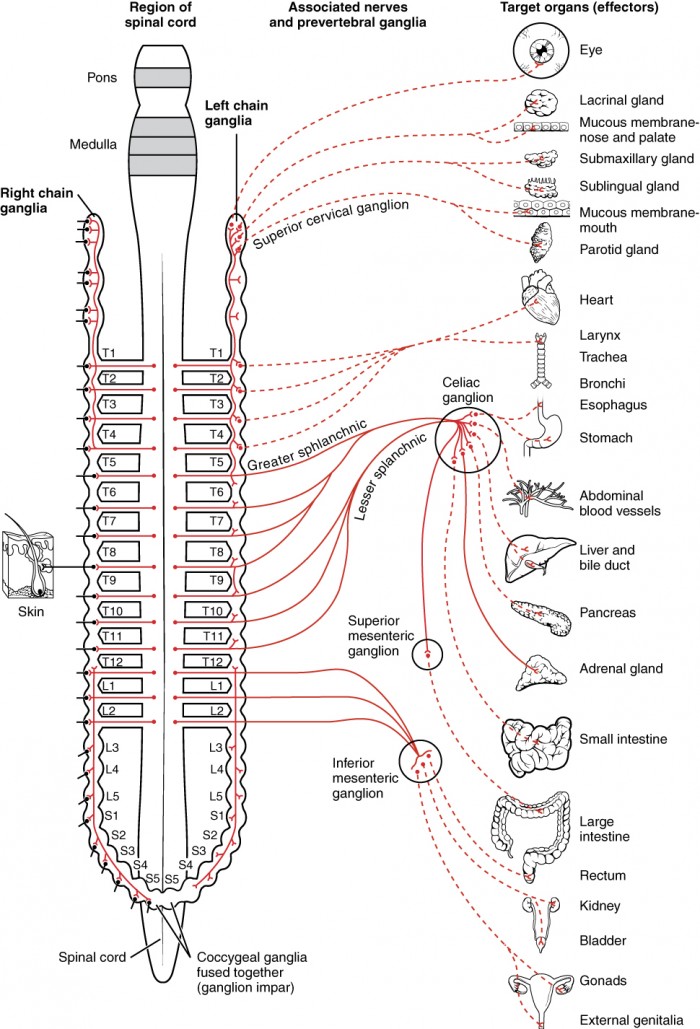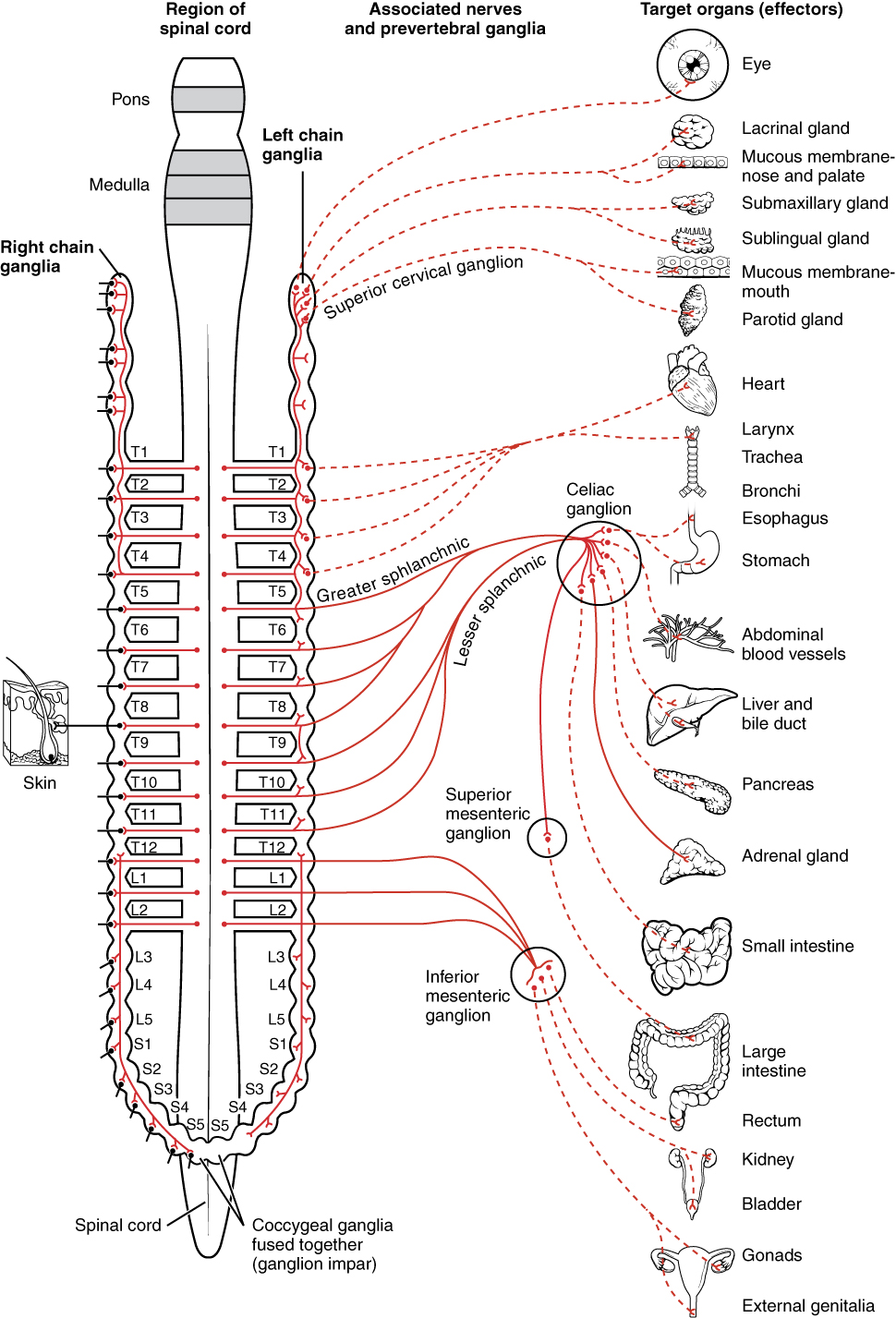Your organs, body tissues, and all the parts of your body – from the biggest to the smallest – are monitored and controlled by your central nervous system. It coordinates all the information and activities in all the other systems of your anatomy. Two major organs comprise your central nervous system – they are the brain and your spinal chord.
It is obvious, therefore, that your spine is connected to the internal organs of your body. Your brain sends and receives information to and from them via your spinal chord. Sensations such as pain are processed by your brain and felt by you because of the messages that passes through your spinal chord. It goes without saying, then, that a blockage or misalignment in your spine can seriously affect the health of your organs, tissue, and other body parts.

Conditions such as numbness, aches, and even disorders in the digestive, excretory, and respiratory systems are detected and sensed by the spinal chord. You should see in the figure above how the different organs, glands, membranes, and tissues of your body are connected to your spine.
This is where chiropractic is coming from – diagnosing, treating, and caring for the spine in order to help in providing remedy for disorders and achieve the optimal health and wellness for the patient.
Care for Your Spine in Your Own Simple Way
Visiting a chiropractor for a regular treatment is a sure sign you care for your spine. Aside from that, you can also take care of your spine in your home, at work, and in doing your day-to-day activities (even how minute they are).
- Sit only when you have to and avoid doing so in prolonged periods.
Your back and spine get stressed more when you are sitting than if you are standing. This is because the discs in the lower part of your spine are receiving 3x more load when you sit down. The thing is, if sitting down is taking a long while, most people would have the tendency to slouch or to bend their head and spine forward. Doing so will only transfer the tension to the discs in the lumbar area of the spine.
If your job involves mostly of desk work, then this tip may be difficult to apply. The workaround for this and to minimise the negative effects of prolonged sitting is to stand, stretch, and walk for a minute every after 30-60 minutes of sitting down.
- Wear proper and comfortable footwear.
You may think that, due to the distance of your foot to your spine, caring for the wellness of the former has no effect on the latter. You got that wrong then.
Particularly on your lower back, your foot posture is essential to maintaining good condition of your spine. Remember, your feet function as the base of your entire body, and proper support to your base provides appropriate alignment to your spine.
Ensure that your shoes have good supportive insoles for your heels, not loose but not overly tight. Just fit enough to make you feel comfortable and to avoid too much supination or over-pronation.
- When lifting an object, lift with your legs and arms – not with your back.
Lifting is an activity that, if not done properly, can wedge the discs in your spine causing unnecessary tensions in your lower back. In severe cases, some people incur spinal injuries because of bad lifting.
Try your best not to bend your torso forward. Bend your knees to reach the object, and lift it utilising the strength of your arms and legs. Do not twist your back or waist when you are in the process of lifting and avoid elevating the object above your shoulders.
- Do abs and back exercise regularly.
Fit and toned muscles in the back and abs are sure ingredients to ensure an excellent support for your spine. They are actually what we call the core muscles. Modern lifestyles may have been the cause why most people incur fatty and unshapely abs and back muscles.
Note that your spine is already supporting the weight of your body. Imagine what tensions it will endure more if you add further weight due to the increasing fat in your waist and belly.
- Rest your spine as you retire to bed.
When you go to bed and sleep, your intention should not just be to recharge your brain and your body’s strength. You should also take your spine to mind. When you are about to sleep, don’t go positioning yourself with those unnatural curves and body bends that put a strain on your back and spine. Use a pillow and a mattress that comfortably relax your spine, allowing it to release all the tensions it had endured throughout the day’s work.
- Don’t hold yourself back from getting a good back massage.
It does not necessarily have to be done by an expert massage therapist (as mentioned in the header, this list is about simple tips you yourself can do – yet this one, in particular, can only be done with the help of a loved one). A good and slightly-hard rub on your back is both soothing and stress-relieving. Massage, even how simple it may be, can release hormones (called endorphins) that help provide remedy to aches and emit pleasurable sensations which are good for your spine’s receptors.
Massage also facilitates better blood flow. So if applied on your back, it can get your spine some rejuvenation from the smooth supply of blood bringing in the needed nutrients and oxygen while washing away waste and toxins.
The chiropractor knows excellently how to apply the best massage on your back coupled with his ability to (re)align your spine to its natural state. Visit your local chiropractor and learn more about caring for your spine, including your body’s overall wellness.
References:
Burke, S. (12 August 2015). “5 Ways to Keep Your Spine Healthy and Happy.” Spine Health. Retrieved from www.spine-health.com
Wolfe, D. “The Real Reason Behind Pain: How the Spine is Connected to Internal Organs!” David Wolfe. Retrieved from www.davidwolfe.com
Healthwise Staff (4 June 2014). “Proper Lifting Technique.” Web MD. Retrieved from www.webmd.com
Image c/o OpenStax College [CC BY 3.0 (creativecommons.org/licenses/by/3.0)], via Wikimedia Commons
Share this article:
